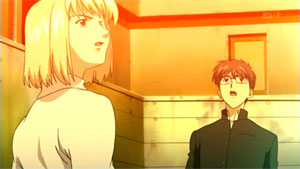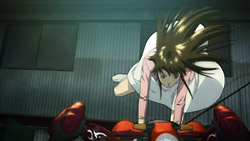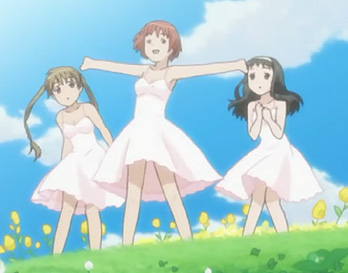Some autumn anime I’ve been following:
Sasameki Koto: I’m still following this story of romantic relationships among girls. The self-absorbed Ushio still hasn’t realised how Sumika feels about her.
Nyan Koi: Amusing story about a boy, Junpei, who is cursed after damaging a roadside cat shrine, with the result that he can understand what cats say, and has to fulfill 100 cat wishes otherwise he’ll turn into one. At the start of the story he secretly is attracted to his pretty classmate Kaede. However as the series progresses one gets to feel that there is a harem thing going on, as while he may be cursed by the cats, he is also attracting a following of good-looking girls.
 Kimi ni Todoke  (=Reaching You): A charming story about the friendship between the shy and awkward Sawako and popular boy, Kazehaya. Sawako has difficulty in relating to other people, and at the start of the story has no friends. Her classmates just think she’s weird, and  persistently mis-pronounce her name as “Sadako” (the name of a creepy character from the “Ring” horror movie). They spread rumours about her occult powers (she hasn’t any, of course.) Kazehaya wants to date her, but Sawako is so lacking in self-esteem that she just doesn’t get it when he says he wants to see her over the summer. Gradually she opens out and makes friends with other girls while falling in love with Kazehaya.
Kimi ni Todoke  (=Reaching You): A charming story about the friendship between the shy and awkward Sawako and popular boy, Kazehaya. Sawako has difficulty in relating to other people, and at the start of the story has no friends. Her classmates just think she’s weird, and  persistently mis-pronounce her name as “Sadako” (the name of a creepy character from the “Ring” horror movie). They spread rumours about her occult powers (she hasn’t any, of course.) Kazehaya wants to date her, but Sawako is so lacking in self-esteem that she just doesn’t get it when he says he wants to see her over the summer. Gradually she opens out and makes friends with other girls while falling in love with Kazehaya.
Cross Game: Still watching this. A new character, Akane, has appeared. Everyone thinks Akane looks startlingly like how Tsukishima Aoba’s dead sister would look now if she was still alive.Â
Aoi Bungaku Series: adaptations of classic Japanese stories. Soseki Natsume’s “Kokoro”, Osamu Dazai’s “No longer Human” (Ningen Shikaku) and and “Run, Melos!” (Hashire Melos). RyÅ«nosuke Akutagawa’s “Hell screen” (Jigoku hen), RyÅ«nosuke Akutagawa’s “The Spider’s Thread” (Kumo no Ito), Ango Sakaguchi’s “In the Forest, Under Cherries in Full Bloom” (Sakura no Mori no Mankai no Shita).
Running order:
4 episodes for ningen shikkaku/No Longer Human
2 for Sakura no Mori no Mankai no Shita/In the Forest, under cherries in full bloom
2 for Kokoro
2 for hashire melos/Run, Melos
1 for Kumo no Ito/The Spider’s Thread
and 1 for Jigoku hen/Hell Screen
Manga artists Takeshi Obata (Death Note), Takeshi Konomo (Prince of Tennis), and Tite Kubo (Bleach) will be involved in the animation’s designs. The first one, which was a grim adult tale set in early 20th century Japan, seemed a bit long and depressing. “In the Forest…” is totally different in style and content, and is superb. “Kokoro” is different again, and again superb. “Run, Melos” is excellent. It refers to an ancient Greek story about Melos.Â
Dropped: To Aru Kagaku no Railgun: a story about some girl students at a college of magic in a magical alternate world. Well-realised and funny. I enjoyed it, but dropped it mainly because there wasn’t an interesting ongoing story. If lesbo groping is your thing, you’ll find it here rather than in the yuri animes reviewed on this page.

 Those of you who like yuri anime may care to note that another one is appearing in the Autumn 2009 Japanese TV anime schedules - an adaptation of the popular yuri manga “Sasameki Koto”.
Those of you who like yuri anime may care to note that another one is appearing in the Autumn 2009 Japanese TV anime schedules - an adaptation of the popular yuri manga “Sasameki Koto”. Fumi (Aoi Hana)
Fumi (Aoi Hana)  Fumi
Fumi Just finished watching Tekkonkinkreet. Another neglected masterpiece! Unusually, it is directed by an American, Michael Arias, who was also involved with “Animatrix” etc. Less unusually, it has a sound-track by two British musicians. Having seen it, I have to say that perhaps Western direction is what anime needs to drag it out of the mediocricy into which it seems to be sinking.
Just finished watching Tekkonkinkreet. Another neglected masterpiece! Unusually, it is directed by an American, Michael Arias, who was also involved with “Animatrix” etc. Less unusually, it has a sound-track by two British musicians. Having seen it, I have to say that perhaps Western direction is what anime needs to drag it out of the mediocricy into which it seems to be sinking. I pulled this off the shelf at random to watch again. It’s a 12-episode TV series from 2003, later made available in the US by Geneon, and there is also a related movie (or OVA) series “Kara no Kyoukai” from 2007.
I pulled this off the shelf at random to watch again. It’s a 12-episode TV series from 2003, later made available in the US by Geneon, and there is also a related movie (or OVA) series “Kara no Kyoukai” from 2007.
